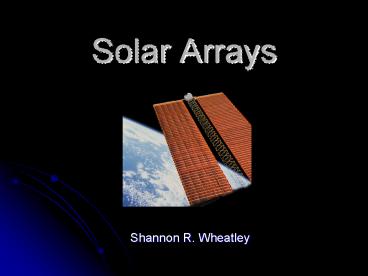Solar Arrays - PowerPoint PPT Presentation
1 / 13
Title:
Solar Arrays
Description:
Discovered in early 1940 by Russell Ohl, a researcher at Bell Telephone Laboratories. ... Total area of 27,000 square feet approximately half an acre ... – PowerPoint PPT presentation
Number of Views:64
Avg rating:3.0/5.0
Title: Solar Arrays
1
Solar Arrays
- Shannon R. Wheatley
2
Outline
- History and Background
- How a solar cell works
- Solar Arrays on the International Space Station
(ISS) - Beta Gimbal Assembly
3
History
- Discovered in early 1940 by Russell Ohl, a
researcher at Bell Telephone Laboratories. - The first solar cells were launched into space on
the US satellite Vanguard I - Solar arrays have appeared on past space stations
such as Skylab and Mir.
4
Solar Cell
Photons from the sun enter the silicon Energy is
given to electrons from the photons Electrons
then flow to the holes located in the n-type The
flow can be directed through an electrical load
thus producing electricity
5
International Space Station Solar Arrays
Final Configuration
- Current configuration
6
ISS Solar Array Specifications
- One solar blanket has 16,400 cells
- Bypass diodes are located every 8 cells
- Final configuration 262,400 cells available for
producing power - Total area of 27,000 square feet approximately
half an acre - Each solar blanket has 82 active panels.
- 41 strings
- Each string is wired in parallel to produce the
required power output. - Primary power (150-160V DC)
- Secondary power (124.5 /- 1.5 V DC)
7
One Solar Array
8
On the Dark Side
- Primary power storage is provided by nickel
hydrogen battery assemblies - During the eclipse, a portion of the stored
battery power is discharged to supply the ISS
loads. - Stored power is not limited to the dark portion
of the orbit. - If the power generation function were to fail,
the batteries could supply power for one complete
orbit following a period of orbital eclipses with
a reduced ISS power consumption rate
9
Beta Gimbal Assembly
- Deployed by either
- Mission Control Center Houston
- Space Shuttle Early Portable Computer System
- Manually with Extravehicular Activity (EVA)
hand-tools.
The mast may retain only about 10 percent of its
strength if it is not fully deployed, depending
on were it stops.
10
Beta Gimbal Orientation
- 360 degree continuous rotations
- Currently the solar array wing is only able to
rotate about its long axis but future missions
will supply equipment to adjust about the axis
perpendicular to the long axis
11
Beta Gimbal Modes
- Autotrack Mode
- Directed Position Mode
- Manual Free Mode
- Blind Mode
12
Key Points
- Solar cells produce power by using the sun
- Solar Array is a combination of solar cells
- ISS
- Currently 4 Solar Arrays
- Completion 16 Solar Arrays
- Nickel hydrogen battery assemblies
- Beta Gimbal Assembly
13
Questions?































